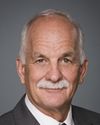Thank you, Madam Chair. I am looking forward to the questions and the hard time.
Madam Chair, honourable members, I am pleased to be with you this afternoon to discuss the 2007-08 main estimates for the Treasury Board of Canada portfolio organizations.
I am joined today by Wayne Wouters, the secretary to the Treasury Board of Canada Secretariat, or TBS; Nicole Jauvin, president of PSHRMAC or the Public Service Human Resources Management Agency of Canada; and Coleen Volk, assistant deputy minister, corporate services branch, Department of Finance; David Moloney, assistant secretary, expenditure management sector, TBS; and Su Dazé, senior financial officer from PSHRMAC.
In my introductory statement, I'd like to present the Treasury Board portfolio of priorities in the context of strengthening public sector management and public service renewal. I am referring to our efforts to make government more effective and realign our priorities along the needs and expectations of Canadians for their government.
After l've concluded, the witnesses and I will be pleased to provide details on the allocation of the funds in the main estimates and respond to your questions and comments.
The Treasury Board portfolio includes the Treasury Board of Canada Secretariat, the Public Service Human Resources Management Agency of Canada, or PSHRMAC, and the Canada School of Public Service.
I'd like to start with the secretariat, which serves as the administrative arm of the Treasury Board. Its mission is to ensure that the government is well managed and accountable, and that resources are allocated to achieve these results.
In fulfilling this mission, the secretariat plays two key central agency roles as a management board and the budget office of government. Through these functions the secretariat also supports the Treasury Board in its role as the principal employer of the public service. In carrying out these functions, the secretariat plays an important leadership role across government in advancing an integrated management agenda.
Today, l want to focus on both of these program areas.
As the management board, our 2007-08 priorities include strengthening governance, accountability, and management practices, including commitments to implement the Federal Accountability Act.
As the budget office, we are strengthening results-based expenditure management, including commitments to support renewal of the expenditure management system. We are already seeing the fruits of our efforts in these areas.
On the management board side, we have successfully led efforts to develop and implement the Federal Accountability Act. We have moved forward on policy renewal, including undertaking reviews of three key policy areas as announced in the federal accountability action plan: financial management, procurement, and grant and contribution programs. We have made progress in strengthening the management accountability framework, an increasingly important tool for tracking departments' progress in improving their management competencies and highlighting deficiencies. We have supported service transformation initiatives. And we have been working on labour-management relations, which should provide us with a good basis for negotiating 24 of 27 collective agreements later this year.
On the budget office side, we have put in place the function for a new expenditure management system. This has included strengthening the quality of financial and expenditure information, working with our central agency partners on our blueprint for the expenditure management system renewal, putting in place plans to strengthen program evaluation, and moving forward with the management resources and results structure policy. This will provide a government-wide approach to the collection, management, and reporting of information.
Looking ahead, we intend to build on this progress. l would now like to highlight a few of the commitments we have in our business plans throughout the portfolio.
Our number one priority is to continue to ensure the seamless implementation of the Federal Accountability Act and action plan across government. We have made great progress to date. Since last December, when the act received royal assent, we have moved swiftly to implement the act, and we will continue on this track until every measure is in force. By implementing the Federal Accountability Act, we are delivering on our promise to make government more accountable.
This is one of the most comprehensive and complex pieces of legislation ever passed in this country, and fully implementing it will take time. But it's worth it. The act and action plan will help restore Canadians' trust in their public institutions and lay the foundation for the more effective government Canadians need and deserve.
As part of our effort to improve accountability in government, we will also continue to renew our suite of policies to clarify the management responsibilities of ministers and deputy heads. We will also continue our efforts to strengthen public sector management by measuring and reporting on management performance through the management accountability framework.
One of the cornerstones of accountability is responsible spending. That is why the government announced directions for a new expenditure management system focused on the priorities of ordinary Canadians. Through this system we are developing a framework for the development and implementation of the government's spending plans and priorities within the limits established by the board.
The new expenditure management system will improve the way departments manage and evaluate the performance of their programs. It will also improve the way cabinet reviews the relevance, funding, and cost-effectiveness of existing programs, and the rigour with which it examines new funding proposals. It will enable us to manage spending more tightly and ensure that government spending achieves results effectively and efficiently. The outcome will result in more oversight and accountability in government.
This new approach to expenditure management is good public administration that will support the following: managing for results by establishing clear responsibilities for departments to better define the expected outcomes of new and existing programs; decision-making for results by ensuring that all new programs are fully and effectively integrated with existing programs, and by reviewing all spending to ensure efficiency, effectiveness, and ongoing value for money; and finally, reporting for results by improving the quality of departmental and government-wide reporting to Parliament.
Through ongoing reviews of all departmental spending on a four-year cycle, the new expenditure management system will make government more efficient and will ensure better value for Canadians' tax dollars.
Let me now turn to the work of the Canada School of Public Service and PSHRMAC.
The Canada School of Public Service serves the learning needs of federal public servants. Key among these is “required training”, as identified in the Treasury Board policy on learning, training, and development. This means making sure that public service employees and managers have training in all the core functions of government, including human resources and financial management.
Looking ahead, its priorities are to deliver and develop individual and organizational learning products to support the public service in meeting the needs of Canadians.
As the focal point for people management in government, PSHRMAC, the agency, leads the development of workplace policies and practices in areas such as learning, official languages, employment equity, and values and ethics. It is also responsible for a number of programs related to employee development, particularly of managers and executives in the public service.
With all components of the Public Service Modernization Act now in force, the agency is focusing on putting in place the mechanisms and infrastructure to support the modernization and renewal of the public service. One result will be increased staffing flexibilities for managers, which will in turn strengthen government accountability.
By strengthening and streamlining how government works, the Treasury Board portfolio is leading the way in making government work better for Canadians. This leadership is important for Canada and Canadians' interests.
A strong, well-functioning, accountable public sector is a competitive advantage. The modernization of public sector management is a challenge that is being addressed across most, if not all, OECD nations, including the United States, Australia, France, Germany, and the United Kingdom.
Canada must keep pace with these broader efforts, and that takes leadership. That's why we are implementing and supporting the Public Service Modernization Act, the Federal Accountability Act and action plan, and the renewal of our expenditure management system. These initiatives affect all of government. They are complex, and their successful implementation requires support and resources. That's why the government has supported growth and resourcing for the Treasury Board portfolio.
Put simply, if we are to meet the aspirations and needs of Canadians in a competitive world, we must make the shift to more accountable, results-based management in the public sector. The estimates we are here to review today reflect this central goal and our commitment to providing leadership in ensuring that Canadians have a government that acts responsibly, rewards integrity, and demonstrates clear accountability—the government Canadians need in the 21st century.
Thank you. I would now be pleased to answer any questions you may have. Or more accurately, I think, my officials will answer the bulk of questions; I will assist where I can. Thank you very much.




